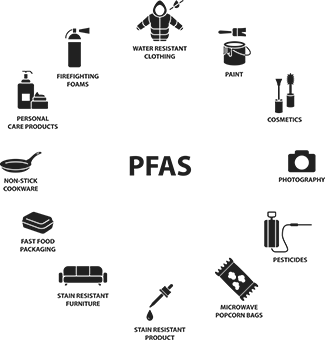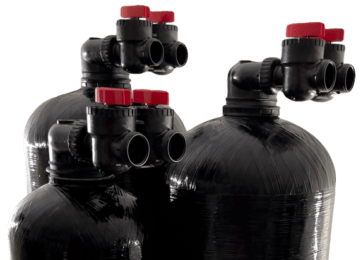
PFAS/PFOS
OVERVIEW AND TREATMENT OPTIONS:
 Per- and polyfluoroalkyl substances (PFAS) are a group of man-made organic compounds used in the United States since the 1940’s for industrial and consumer applications such as nonstick coatings and firefighting foams. This group of chemical includes PFOS (perfluoroctanesulfonic acid) formerly used in Scotch Guard, PFOA (perfluorooctanoic acid) which was the main ingredient in Teflon, & PFNA (perfluorononanoic acid) to name just a few. These compounds have been detected in drinking water systems in recent Environmental Protection Agency (EPA) testing. They are persistent in the environment and highly soluble in water. Unfortunately, the technology that makes them useful is also the reason they persist in the environment.
Per- and polyfluoroalkyl substances (PFAS) are a group of man-made organic compounds used in the United States since the 1940’s for industrial and consumer applications such as nonstick coatings and firefighting foams. This group of chemical includes PFOS (perfluoroctanesulfonic acid) formerly used in Scotch Guard, PFOA (perfluorooctanoic acid) which was the main ingredient in Teflon, & PFNA (perfluorononanoic acid) to name just a few. These compounds have been detected in drinking water systems in recent Environmental Protection Agency (EPA) testing. They are persistent in the environment and highly soluble in water. Unfortunately, the technology that makes them useful is also the reason they persist in the environment.
TESTING
The EPA has established a health advisory level at 70 ppt (parts per trillion), however it has not established regulatory limits for PFAS chemicals (early 2021). The advisory levels set by the EPA are established to be protective for the most sensitive individuals against reproductive and developmental impacts with a margin of safety. Instead, several states have announced or are considering their own regulations and guidelines for PFAS in groundwater and drinking water with the goal to reduce the amount of these compounds in the environment. States with Specific Maximum Contaminant Levels (MCLs) include:
- 2023: EPA passes MCL of 4 ppt for PFAS/PFOS https://www.epa.gov/sdwa/and-polyfluoroalkyl-substances-pfas
- Connecticut has established five PFAS not to exceed 70 ppt. They are PFOA, PFOS, PFNA, PFHxS, and PFHpA.
- Massachusetts adopted drinking water MCLs for PFOS (3.3 ppt), PFOA (3.3 ppt), PFNA (3.3 ppt), PFHpA (3.3 ppt), PFDA (3.3 ppt) and not to exceed 20 ppt combined.
- Michigan adopted groundwater cleanup standards for PFNA (6 ppt), PFOA (8 PPT), PFOS (16 ppt).
- New Hampshire adopted drinking water MCLs for PFOA (12 ppt), PFOS (15 ppt), PFHxS (18 ppt), and PFNA (11 ppt)
- New Jersey adopted MCLs for drinking water and groundwater standards: PFOS (13 ppt), PFOA (14 ppt) PFNA (13 ppt)
- New York established MCLs for PFOA and PFOS of 10 ppt individually
- Vermont adopted a drinking water MCL for PFHxS, PFHpA, PFNA, PFOS, and PFOA of 4 ppt individually and 20 ppt combined.
SOURCES
PFAS can be found in living organisms such as animals, fish, and humans. These chemicals are persistent and have the ability to build up over time. They are in household products including nonstick products like Teflon, stain and water repellent fabrics, cleaning products, waxes, polishes, and fire-fighting foam. A major source of groundwater contamination at airports and military bases were firefighter training stations. PFAS are found in places of work including production facilities that chrome plate, manufacturer electronics, or oil recovery. They are found in materials that package food, equipment that processes food, and it’s found in the soil and/or water that it’s grown in. PFAS are also in our drinking water. These groundwater sources are typically associated with a specific facility like a firefighter training site, manufacturer, wastewater treatment plant, or a landfill. In all, these chemicals can be found everywhere and are becoming more prevalent in our daily lives. Although PFOA and and PFOS are no longer manufactured in the United States, they are still imported in consumers goods such as rubber and plastics, leather and apparel, paper and packaging, coatings, and carpets.
HEALTH CONCERNS
There is evidence that by ingesting PFAS (through eating food or by drinking water containing PFAS), they will be absorbed and can accumulate in the body remaining there for a long period of time. So as people become exposed to PFAS from alternative sources over time, the level of PFAS in their bodies may increase. This exposure to PFAS may lead to adverse health outcomes in people. Health risks can include developmental effects of fetuses during pregnancy or to breastfed infants, effects on the liver, cancers, immune effects, thyroids effects, and more. This is an emerging list of contaminants so check your local health departments for concerns in your area.
TREATMENT
There are effective technologies that have shown drastically deduce PFAS from water supplies. Each technology has things to be considered, including feasibility of operation and costs that would need to be thought of initially. These treatment approaches include:
ACTIVATED CARBON TREATMENT – When removing PFAS with carbon it all comes down to the pore structure. Carbon that has smaller pores will be able to remove the smaller, more soluble organics. Whereas some carbon types have a more open pore structure to take out some of the larger organics, as well. Therefore, the general line for PFAS removal with carbon would be this: Carbon with a smaller pore structure would be your best bet if there is little to no TOC in the water. If there is a high concentration of other organics in the water this can “clog” up the carbon and it won’t be as effective. Use a carbon with a more open pore structure to accommodate TOC and other organics present. Therefore, you can remove a wider array or organics including the PFAS.
- ION EXCHANGE RESINS – Resin beads (made up of hydrocarbons) work similar to carbon. PFAS are drawn to the resin beads like a magnet and are removed as water passes through.
- REVERSE OSMOSIS – Process of passing water through tightly wound membranes with condensed pores. The membrane will act like a wall preventing chemicals and other particles from passing into the water supply.


